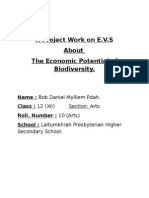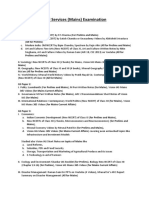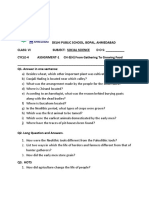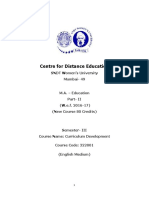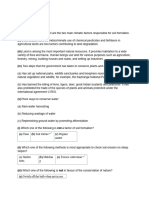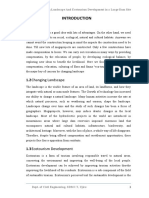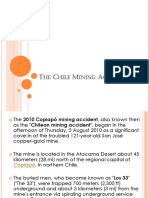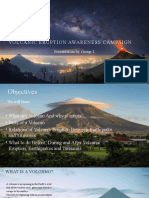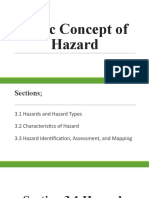Professional Documents
Culture Documents
A+ Blog - Std-9-Social Science Ii-Chapter-7-For The Safer Future - Questions and Answers
A+ Blog - Std-9-Social Science Ii-Chapter-7-For The Safer Future - Questions and Answers
Uploaded by
Maria GeorgeOriginal Description:
Original Title
Copyright
Available Formats
Share this document
Did you find this document useful?
Is this content inappropriate?
Report this DocumentCopyright:
Available Formats
A+ Blog - Std-9-Social Science Ii-Chapter-7-For The Safer Future - Questions and Answers
A+ Blog - Std-9-Social Science Ii-Chapter-7-For The Safer Future - Questions and Answers
Uploaded by
Maria GeorgeCopyright:
Available Formats
A+ SOCIAL SCIENCE II STD - IX
UNIT:7
FOR A SAFER FUTURE
1. Which are the places in Kerala where tea and spice crops are cultivated in large scale? How far has
the environment influenced the human life in these places?
Ellukochi, Rajapuram and Ranipuram (eastern regions of Kasargod)
Iritty, Peravoor and Aralam (The hilly regions of Kannur)
Kattappana, Nedumkandam, and Udumbanchola(Idukki)
Provides cool climate, determines the crops that can be cultivated
2. Name the factors which constitute environment?
Climate, topography, soil, agriculture, plants, animals and man
3. What activities has man undertaken in his efforts to adapt with his environment?
Constructed roads along difficult terrain.
Hill slopes were terraced for agriculture.
Built houses in possible areas.
4. How is the human life in the deserts where dusty winds blow continuously?
The style of dressing of the people of the Arabian deserts have close relation with the climate
of that region.
Agriculture is generally poor as water is scarce.
Arabian deserts region is densely populated and is quite prosperous as well due to the rich
petroleum deposits.
5. Write an example of a place situated below sea level in Kerala?
Kuttanad
6. The topography of Kuttanad is very rare even in the world. Justify
People living amidst the backwaters and other water logged areas have reclaimed the land
through immense toil.
Lifestyle is centred on duck farming, paddy and coconut cultivation, etc.
Tourism has also become an important activity in the life of these people.
7. Write the factors that prevent human habitation in snow-covered Siberian region?
Limited resources and hostile climate
8. What if the petroleum in the Arabian region gets exhausted due to over-exploitation?
Arabian countries face crucial situation
Poverty, starvation, unemployment
Affect whole world oil transportation
9. The delicate balance of the environment in Kuttanad is on the verge of destruction. What will be the
possible consequences?
A+ BLOG- www.apluseducare.blogspot.com Whatsapp 9746544422 Page 1
A+ SOCIAL SCIENCE II STD - IX
Destruction of the eco- system
Destruction of marine organisms
Tourism sector will diminish
Unemployment & poverty
10. What are the measures adopted by the people of Siberia for their life?
They built their houses using snow
Wear woollen clothes
Fishing & hunting - occupation
11. Why Environmental protection is important?
The interventions of man in nature with selfish motives will have adverse effects.
Interaction in nature without disturbing its diversity is an important aspect in the conservation
of the environment.
Conservation of the environment and its diversity is a must for the healthy sustenance of not
only man but all life forms as well.
12. What are natural hazards? Write any two examples
Natural phenomena that are hazardous to life, property and environment are known as natural
hazards.
Landslides, earthquakes
13. What do you meant by natural disasters?
Disasters occurring due to natural causes are termed as natural disasters.
14. List out the natural disasters occurring in India.
Cyclone • Lightning• Earthquake • Tsunami• Landslide • Flood• Hailstorm • Avalanche •
Drought • Frostbite
15. Kerala is one of the states prone to natural calamities. Justify
Expanse of backwaters bordered by the slanting coconut trees
lush green midland
cool mountain slopes in the east
16. Identify the most widespread natural disaster in Kerala?
Landslides
17. Which physiographic unit in Kerala experiences landslides the most?
The highlands of Kerala
18. What is landslide?
During severe rains, large quantity of water seeps into the soil.
This exerts pressure on the pores in the soil.
A+ BLOG- www.apluseducare.blogspot.com Whatsapp 9746544422 Page 2
A+ SOCIAL SCIENCE II STD - IX
Due to the pressure of water, the soil under the loose rocks will move downwards.
Due to gravity, the whole or part of the area will collapse with great noise.
This phenomenon is known as landslide.
National Centre for Earth Science Studies has identified that places with slope above 20° are
prone to landslides.
19. How are streams formed in the hilly terrains?
After the landslide, the water stored in the soil starts flowing down as streams.
Many a time this flow will last only for a few days.
But on some occasions, there may become permanent streams
20. What are the unscientific activities along hilly terrains?
Demolishing hillsides for soil.
Cultivation of crops that need frequent tillage along steep slopes.
Construction of houses and other buildings along steep slopes.
21. Why do we say that the land utilization should be scientific in Kerala?
Lack of space is one of the crucial problems that Kerala faces.
More than 30% of the total land area of Kerala consists of slopes.
Hence it is very essential that land utilization should be scientific.
22. Write scientific land use practices
Hill sides may be transformed into terraces in order to reduce the slope.
The course of the natural streams in the hilly terrain should not be blocked.
Construction activities along steep slopes should be avoided.
23. In what scale Earthquake disaster intensity in Kerala is measured?
Moderate earthquake disaster
24. What are the precautions we should take for the Earthquake disaster?
The construction of large buildings in seismically active zones should be avoided.
Adopt seismic resistant construction.
Light roofs are comparatively safe
25. What is flood?
When a large quantity of water flow into the rivers during the rainy season, the river will not
be able to hold the excess water and it overflows. This is known as flood.
26. What is flash flood?
The phenomenon of sudden rise of water level following heavy rain is known as flash flood
27. What are the precautions adopted in order to avert the danger of flood?
Do not build houses on the river banks.
A+ BLOG- www.apluseducare.blogspot.com Whatsapp 9746544422 Page 3
A+ SOCIAL SCIENCE II STD - IX
Do not reclaim the paddy fields. They are the natural sinks for rain water.
Construct bunts on the river banks.
28. What do you meant by disaster mitigation measures.
It is impossible to prevent natural disasters.
We can reduce their impact and bring the people back to normal life through properly planned
interventions. Such actions can generally be called disaster mitigation measures.
29. List out the general measures to be followed in the event of natural disasters.
Provide immediate medical aid to the injured.
Do not believe or spread rumours.
Keep only precious items or documents along with you. Drink boiled water only.
Keep the necessary medicines with you.
30. Flow chart - three stages for disaster mitigation measures.
31. What steps we must adopted to ensure our safety in the event of natural hazards in schools?
For that the safe spots of the school have to be identified in advance.
Areas away from the buildings, preferably the middle of the play ground will be the safest.
This is because of the fact that even if the building collapses the debris might not fall here.
Decide the path for ambulances and other rescue vehicles to the school campus.
Do not make any modification in the campus obstructing this.
The safe spots may be marked clearly for everyone's knowledge.
Mock drills to tackle disaster situations may be carried out at intervals.
32. Name the authority which is entrusted with the task of coordinating the disaster mitigation measures
in Kerala?
The Kerala State Disaster Management Authority (KSDMA)
A+ BLOG- www.apluseducare.blogspot.com Whatsapp 9746544422 Page 4
A+ SOCIAL SCIENCE II STD - IX
33. Flow chart - lists on the various steps to be followed in the event of natural disasters.
34. What is the role of children in disaster management?
Prepare and circulate pamphlets and exhibit notices in public places explaining the steps to be
adopted by the people in emergency situations.
Organize orientation programmes on scientific land-use practices.
35. Describe the functions of SEOC & DEOC.
The State Emergency Operations Centre (SEOC) supervises the disaster mitigation measures
in the various districts.
A+ BLOG- www.apluseducare.blogspot.com Whatsapp 9746544422 Page 5
A+ SOCIAL SCIENCE II STD - IX
It issues warnings of disaster possibility and measures to be adopted in the event of
emergency situations.
District Emergency Operations Centre (DEOC) is responsible for the disaster management
activities of a particular region.
Warnings to people are issued through these centres.
36. Write the mission of SEOC & DEOC.
To coordinate the actions of various government departments such as health, law and order,
fire force, and public works in disaster management activities.
Prepared by,
PRIYA B
HST(SS)
CSHSS THRISSUR
More Resources, Visit https://apluseducare.blogspot.com/
Telegram Group: https://t.me/joinchat/ELv60hbE_g9Hvimlp0s1BA
A+ BLOG- www.apluseducare.blogspot.com Whatsapp 9746544422 Page 6
You might also like
- Project-Flood & Disaster ManagementDocument6 pagesProject-Flood & Disaster ManagementBinode Sarkar79% (52)
- Revisiting Delors Commission Report (1996) On The Pathway of VivekanandaDocument6 pagesRevisiting Delors Commission Report (1996) On The Pathway of Vivekanandapradip sengupta100% (1)
- Richard GroveDocument7 pagesRichard GroveAnjala philipNo ratings yet
- Unit - 7 Kerala - From Eighth To Eighteenth CenturyDocument9 pagesUnit - 7 Kerala - From Eighth To Eighteenth Centuryashwajit 8B100% (1)
- Sengupta - Repair of RecordsDocument15 pagesSengupta - Repair of RecordsPinaki ChandraNo ratings yet
- Ganga Ghat by Raja Rao Theme PDFDocument51 pagesGanga Ghat by Raja Rao Theme PDFMonu BumraNo ratings yet
- Andaman and Nicobar Islands TsunamiDocument10 pagesAndaman and Nicobar Islands TsunamiHarshit SalujaNo ratings yet
- GSEB Solutions Class 10 Social Science Chapter 7 Preservation of Our HeritageDocument20 pagesGSEB Solutions Class 10 Social Science Chapter 7 Preservation of Our HeritageKriti ShahNo ratings yet
- 9.chapter IVDocument71 pages9.chapter IVapplesbyNo ratings yet
- The Economic Potential of BiodiversityDocument5 pagesThe Economic Potential of Biodiversitydarthlucasx80% (5)
- Later-Vedic Edn SystemDocument14 pagesLater-Vedic Edn SystemsatyaNo ratings yet
- GSEB Solutions Class 10 Social Science Chapter 4 Literary Heritage of IndiaDocument24 pagesGSEB Solutions Class 10 Social Science Chapter 4 Literary Heritage of IndiaKriti Shah100% (1)
- Edu 201 Module 2 Print Paedocentric EducationDocument8 pagesEdu 201 Module 2 Print Paedocentric Education97952918meNo ratings yet
- Indus Valley CivilisationDocument5 pagesIndus Valley Civilisationmrkaukumar0% (1)
- Presentation - Forest & Wildlife Class XDocument46 pagesPresentation - Forest & Wildlife Class XKapil VermaNo ratings yet
- Field Report-AndroDocument24 pagesField Report-AndroMutum BudhamaniNo ratings yet
- Vedic AgeDocument19 pagesVedic Ageamita guptaNo ratings yet
- Primitive ActivityDocument18 pagesPrimitive ActivitySaoda Feel Islam100% (1)
- EVS (Diaster Managment)Document8 pagesEVS (Diaster Managment)Manasvi Dawane100% (1)
- Maurya EmpireDocument63 pagesMaurya EmpireVishal MauryaNo ratings yet
- Social Studies UnitDocument7 pagesSocial Studies Unitapi-302584405No ratings yet
- Diiferential Diagnosis of West Bengal and UttarakhandDocument11 pagesDiiferential Diagnosis of West Bengal and UttarakhandshankarmondalNo ratings yet
- SC 2024 SP-7Document16 pagesSC 2024 SP-7Swostik Rout100% (1)
- PPT-Tracing Changes Through A Thousand YearsDocument11 pagesPPT-Tracing Changes Through A Thousand YearsHarshit SalujaNo ratings yet
- Ncert Book Class 8 Disaster ManagementDocument63 pagesNcert Book Class 8 Disaster ManagementVENKATA RAMANA100% (2)
- Unit1 (4.1) 5 Marks Question and Answers Ethics and Values Semester 4.Document4 pagesUnit1 (4.1) 5 Marks Question and Answers Ethics and Values Semester 4.SandipNo ratings yet
- Biodiversity Hot SpotsDocument19 pagesBiodiversity Hot Spotsrage nagalingamNo ratings yet
- Sumit Kumar - AIR 53 - Books & Notes List - Prelims and MainsDocument2 pagesSumit Kumar - AIR 53 - Books & Notes List - Prelims and MainsPRATEEK KUMAR DASNo ratings yet
- II Contemporary India and EducationDocument4 pagesII Contemporary India and EducationKAVITHA K JNo ratings yet
- Digital AlbumDocument21 pagesDigital AlbumJince JosephNo ratings yet
- Assignment L-3 History Gathering To Growing FoodDocument3 pagesAssignment L-3 History Gathering To Growing Foodsumendra singhNo ratings yet
- Mulidar CommisiionDocument6 pagesMulidar CommisiionSharanu Patil100% (1)
- CD PDFDocument94 pagesCD PDFKure RukminiNo ratings yet
- CBSE Class 8 Social Science Geography Important Questions Chapter 2Document8 pagesCBSE Class 8 Social Science Geography Important Questions Chapter 2rashmirekhasahoo917No ratings yet
- Social Class10Document16 pagesSocial Class10siddharthNo ratings yet
- Evs QBDocument30 pagesEvs QBDilip KumarNo ratings yet
- Surya The Global School: Master NotesDocument16 pagesSurya The Global School: Master Notesror ketanNo ratings yet
- Disasters and Their Management: Module - 4Document21 pagesDisasters and Their Management: Module - 4Dinesh MehtaNo ratings yet
- Answers KeyDocument8 pagesAnswers Keyvincent.dass81No ratings yet
- Quiz 2 Climate Change ReviewerDocument5 pagesQuiz 2 Climate Change ReviewerGARCIA, KYLA MAE A.No ratings yet
- Unit 2Document10 pagesUnit 2samyukthaagr.0905No ratings yet
- DRRR 11 - 12 0601 Ground Subsidence PSDocument17 pagesDRRR 11 - 12 0601 Ground Subsidence PSEdna Liwliwa C. GabuyoNo ratings yet
- Unit .. 3Document14 pagesUnit .. 3aparnadevi0704No ratings yet
- Security and RisksDocument65 pagesSecurity and RisksKranti TejanNo ratings yet
- Geography RevisionDocument7 pagesGeography Revisionhassantv900No ratings yet
- Evs Question and AnswersDocument17 pagesEvs Question and AnswersSuganya MNo ratings yet
- Geography-Resources and Development Q - ADocument7 pagesGeography-Resources and Development Q - ANaman GamingNo ratings yet
- Kingsway Christian Academy: WWW - Kingsway.edu - PHDocument4 pagesKingsway Christian Academy: WWW - Kingsway.edu - PHAldrin CastanetoNo ratings yet
- EVS UNIT 2 NotesDocument21 pagesEVS UNIT 2 NotesNivashini VindhyaNo ratings yet
- MLP Land Soilwater and Natural Vegetation 1Document7 pagesMLP Land Soilwater and Natural Vegetation 1PianoPianistNo ratings yet
- 20210504-Std - VIII2. G - NATURAL RESOURCES - LAND, SOIL, WATER, NATURAL VWGETATION AND WILD LIFEDocument4 pages20210504-Std - VIII2. G - NATURAL RESOURCES - LAND, SOIL, WATER, NATURAL VWGETATION AND WILD LIFEHardik KarelNo ratings yet
- Evs With Answeres PDFDocument26 pagesEvs With Answeres PDFbeslinNo ratings yet
- Unit IV Social Issues and The Environment Important QuestionsDocument3 pagesUnit IV Social Issues and The Environment Important Questionsjowelantonio20No ratings yet
- 01-Resource and Development (Part-01)Document5 pages01-Resource and Development (Part-01)Archit AggarwalNo ratings yet
- Changing Landscape and Ecotourism Development in A Large Dam SiteDocument16 pagesChanging Landscape and Ecotourism Development in A Large Dam Siteವಿನಯ್ ಎಮ್. ಆರ್No ratings yet
- Unit 1Document9 pagesUnit 1bakknoncontimNo ratings yet
- kELAS 12Document1 pagekELAS 12Maulana Mufti MuhammadNo ratings yet
- Conlene Pontejo Bs-Abe - 1A Environmental ScienceDocument4 pagesConlene Pontejo Bs-Abe - 1A Environmental ScienceConlene PontejoNo ratings yet
- Chapter 1Document28 pagesChapter 1sangeetha nagarajNo ratings yet
- Chapter 1 GeographyDocument6 pagesChapter 1 GeographyTapas BanerjeeNo ratings yet
- Case Study Sheet - MontserratDocument3 pagesCase Study Sheet - MontserratRichard HampsonNo ratings yet
- Daman Mock ExerciseDocument13 pagesDaman Mock ExercisekarpanaiNo ratings yet
- TSUNAMIS PPT - Final PDFDocument34 pagesTSUNAMIS PPT - Final PDFnikhil singhNo ratings yet
- Science 5 St2 Pt2 q4Document3 pagesScience 5 St2 Pt2 q4florida bambicoNo ratings yet
- 2º Medio - English Test Unit 5 Our Changing WorldDocument13 pages2º Medio - English Test Unit 5 Our Changing WorldPancho OportusNo ratings yet
- Malaysia Airlines Flight 370Document1 pageMalaysia Airlines Flight 370Ana Gabriela Gonzalez RNo ratings yet
- Science10 q1 Mod1Document18 pagesScience10 q1 Mod1Nexo NuñezNo ratings yet
- Essay On Heart BreakDocument3 pagesEssay On Heart Breakdivya chandNo ratings yet
- 2024 Budget ResolutionsDocument8 pages2024 Budget ResolutionsAlibtak DlyNo ratings yet
- 3 1 Stevedore Damage ReportDocument2 pages3 1 Stevedore Damage ReportDillip KUMAR JENA100% (1)
- Assignment 2Document19 pagesAssignment 2Usman GillNo ratings yet
- Cyclone Freddy - WikipediaDocument3 pagesCyclone Freddy - Wikipediaw56fxqgjcpNo ratings yet
- KEy Component of DRRMDocument21 pagesKEy Component of DRRMMARGARITA MARIANONo ratings yet
- English 5 q1 W9 Day 1-3Document43 pagesEnglish 5 q1 W9 Day 1-3GENEVA RAMOSNo ratings yet
- Quiz For Grade 10Document2 pagesQuiz For Grade 10Von Lloyd Loren50% (2)
- Attendance Sheet TraijunjunningDocument3 pagesAttendance Sheet TraijunjunningHarold John AgustinNo ratings yet
- The Chile Mining AccidentDocument8 pagesThe Chile Mining AccidentRehman AbbasiNo ratings yet
- Analysis On Explanation TextDocument2 pagesAnalysis On Explanation Textasih dwi astutiNo ratings yet
- Uncovering The Root Causes and Far-Reaching Impacts of Floods and Landslides in Brooke's Point, PalawanDocument9 pagesUncovering The Root Causes and Far-Reaching Impacts of Floods and Landslides in Brooke's Point, PalawanPsychology and Education: A Multidisciplinary JournalNo ratings yet
- The Causes of A Natural DisasterDocument2 pagesThe Causes of A Natural Disastervaleriagonzalez1No ratings yet
- Volcanic Eruption Awareness Campaign: Presentation by Group 1Document16 pagesVolcanic Eruption Awareness Campaign: Presentation by Group 1Xcel MoralesNo ratings yet
- Earthquake Drill PresentationDocument19 pagesEarthquake Drill Presentationjowindel mandabon100% (1)
- Performance Task DRRR 4th QuarterDocument1 pagePerformance Task DRRR 4th QuarterLawrence Carl100% (1)
- Cezar John Bernales 2 Yr. BLK 4 Chapter 6 Jail Custody, Security, Control and Discipline of InmatesDocument3 pagesCezar John Bernales 2 Yr. BLK 4 Chapter 6 Jail Custody, Security, Control and Discipline of InmatesMichael Jorge BernalesNo ratings yet
- Study MaterialsDocument2 pagesStudy MaterialsJuanaleNo ratings yet
- Mediatrix Homes, Inc. Fire Coc June 2023-2024Document1 pageMediatrix Homes, Inc. Fire Coc June 2023-2024Penguin 37No ratings yet
- Ofppt Ista:Lamkinsia /isma Communication en Anglais Formatrice:El Mahfoudi KarimaDocument3 pagesOfppt Ista:Lamkinsia /isma Communication en Anglais Formatrice:El Mahfoudi Karimaافكار و معلومات ناذرةNo ratings yet
- Lesson 3 - The Philippine DRRM SystemDocument17 pagesLesson 3 - The Philippine DRRM SystemRafael OseoNo ratings yet
- Padma Nadir Majhi Assigment 2Document2 pagesPadma Nadir Majhi Assigment 2shanjidhaqueshachchawNo ratings yet
- Basic Concept of HazardDocument32 pagesBasic Concept of HazardCheelsy P. ButronNo ratings yet









